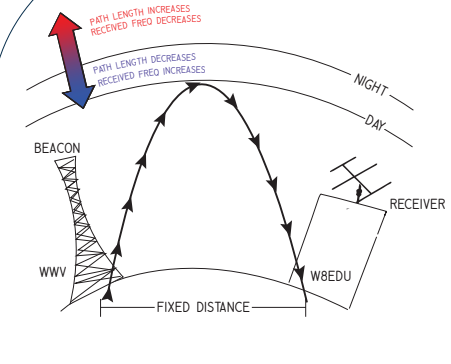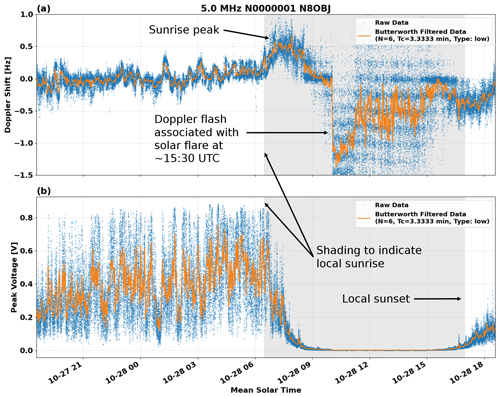The Grape Personal Space Weather Station (PSWS) (Archival)
This page is an archival copy of the GRAPE PSWS page from the 2020-2023 era. We suggest you visit the latest HamSCI PSWS pages for current information
The Grape* PSWS Project - A Distributed Array of Software Defined Receivers
The HamSCI Personal Space Weather Station (PSWS) Project is making available, to the radio hobbyist and space physics communities, a distributed array of Low IF radio receivers. They are designed with a specific purpose in mind: Recording changes in the Earth's ionosphere through measurements of Doppler frequency shifts observed by monitoring, on a 24/7 basis, frequency standard stations such as WWV/H and CHU.
Ham radio operators and other shortwave enthusiasts are encouraged to host Grape receivers at their stations from now until well after the total North American solar eclipse on April 8, 2024. Hosting involves providing reliable power, space for an antenna and an Internet connection. Other factors come into play, such as the need for visibility to the constellation of GPS satellites.
The science behind the Grape PSWS project is described below. In short, the array of Grape PSWS receive signals from the frequency standard stations, make extremely accurate measurements of the received frequency, record and then upload the data. Measurements accuracies are in the milliHertz range. Space physicists and citizen scientists can then use those measurements to study the effects of solar phenomena (e.g., flares, CMEs and eclipses) on the ionosphere.
*Why is it called 'Grape'? Because it is the Great Radio Amateur Propagation Experiment, and because Grapes work best in 'bunches' - the more deployed to the field, the better!
Grape 1 fldigi and Grape 1 DRF: Single-Channel Receivers
Grape 1s are designed for DIY enthusiasts. The single-frequency receiver portion is built by the user on a PC board using surface mount components. The user then has to obtain and assemble the system components, such as a GPS disciplined oscillator, a Raspberry Pi, USB audio interface, power supply, storage medium and antenna. All components are readily available and thoroughly documented. Note that Grapes are like any hardware/software based product; they have evolved over time and there are multiple versions in use.
- The first Grape systems run a highly modified version of fldigi software. Dozens are in use, collecting data on a 24/7/365 basis. Each system uploads data, once per day, to a server hosted by the WWV ARC. Grape fldigi data has been collected since 2019. Those Grapes provide valuable data and are expected to keep running throughout 2023 and 2024. Construction and software details, along with information on initiating the data collection and uploading processes, are on the Grape 1 page.
- Grape 1 systems running GNU Radio software, collecting data in the Digital Radio Format, was released in September of 2023. It is the first Grape model to upload data to the Personal Space Weather Station Central Control System. Construction details are located on the Grape 1 page, while guides to the software, data collection methods and more are on the Grape 1 DRF documentation page.
The Grape 2 Multi-Channel Receiver
The Grape 2 is more sophisticated 3-channel receiver. However, the extra complexity requires that the PC boards be commercially built. Over 30 Grape 2s were deployed prior to the April 8, 2024 total solar eclipse over North America. Details, photos and a map of the host stations are on the Grape 2 web page.
Please note that the Grape Low IF radios are not general purpose receivers. They are designed to receive signals only on frequencies pertinent to the research.
How Can I Participate?
HamSCI strongly encourages anyone with interest and/or experience in the areas of shortwave radio reception, kit building, system assembly, single-board computer application to read through the details on the Grape 1 and 2 and decide which approach would be best for you.
- Grape 1 sites require no registration beyond requesting a node number for uploading data to the a central server (data repository). Directions for obtaining a node number are on the Grape 1 page.
- Approximately 30 Grape 2 sites were funded through research grants. All have been deployed. There are no plans for building additional units, though that could change in the future.
All Grape participants should join the hamsci-grape Google Group. All are welcome to participate in weekly Grape Zoom calls to share hints, hacks, and results. Questions are always welcome - if you have a question, chances are that many others have the same question - the community is very welcoming in that regard. (The Zoom calls are recorded and made available on the HamSCI YouTube channel.)
The Science Behind the Grape PSWS Project
The following is an abbreviated summary of the science behind the Grape PSWS network and how the Grape creates valuable data for scientific study. It is recommended that the reader follow the links at the end of this section to gain a full understanding of the concepts described here. Before diving in, it would be helpful to understand Doppler effect, and also to be aware of the HamSCI glossary.
Scientific Interests
The PSWS network has proven to be useful in the study of short-term (lasting hours to days) geophysical and solar events, such as traveling ionospheric disturbances, solar flares, solar eclipses and geomagnetic storms. It does so by observing the bottom side of the ionosphere. Data from PSWS member stations, often combined with observations from other scientific instruments, yields clues as to how and why those events impact HF (high-frequency, 3–30 MHz) radio wave propagation. The data can also be used to improve mathematical models of the ionosphere, which should result in more accurate predictions of HF propagation (such as maps of the MUF and critical frequencies).
Role of the Grape PSWS
HF Doppler sounding is an established means of observing the bottom side of the ionosphere. Its principle of operation is straightforward: A shift in signal path length causes a corresponding Doppler shift (Figure 1). The Grape receiver performs Doppler measurements by measuring the carrier freqency of frequency standard stations such as WWV/H (or CHU). Their transmit frequency accuracy and stability is less than one part in 10^13 - an incredibly small value. Measurements of the WWV/H frequency at a distant receiver site is limited by a few factors, one of which is the receiver’s accuracy and stability, the other is the propagation path. The former is well accounted for in the design of the PSWS, the latter is the primary measurement of interest. In other words, those who study the PSWS measurements are not overly concerned about the absolute value of the receive frequency, but they are extremely interested in the variation of the received frequency over time (typical PSWS datasets are broken into 24 hour periods) (Figure 2).

Figure 1: A simplified illustration of the relationship between rate of change in ionospheric layer height and received frequency shift. Precision frequency standards are required at both beacon and receiver in order to make an effective comparison. Frequency variation is generally on the order of ±1 Hz. Multihop propagation (multiple reflections between ionosphere and ground), Pedersen modes (internal ionospheric reflections), asymmetric paths, and other factors impacting path length are not shown. Reproduced from Collins et al. (2022).

Figure 2: Annotated frequency and amplitude plots of Node 1's 5 MHz data from 28 October 2021, with sunrise and sunset indicated by background shading. The filtered result is superimposed on the raw data. The day's sunrise peak is clearly visible. The horizontal axis is plotted in mean solar time, rather than UTC, in order to emphasize the effects of the 24-hour day/night cycle. A Doppler flash associated with an X-class solar flare is evident around 15:30 UTC. Reproduced from Collins et al. (2022).
For further information, please review these papers, presentations and posters. More on this subject can be found in the Publications on this site.
- Grape Personal Space Weather Station Doppler Observations (peer reviewed paper)
- The potential of HamSCI Doppler Observations for inferring Solar Flare Effects on the Ionosphere (conference proceeding)
- HF Doppler Observations of Traveling Ionospheric Disturbances in a WWV Signal Received with a Network of Low Cost HamSCI Personal Space Weather Stations (poster and explanatory video)
Grape PSWS Project Sponsors and Supporters

17 October 2025: Updated PSWS CCS URL - af8a
